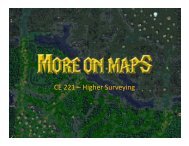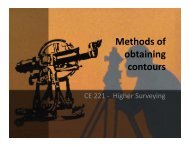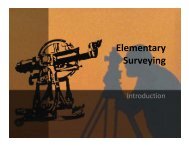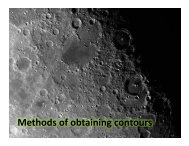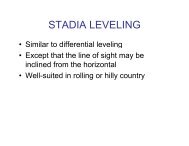TACHEOMETRY
TACHEOMETRY - WordPress.com - Mindthreshold
TACHEOMETRY - WordPress.com - Mindthreshold
- No tags were found...
Create successful ePaper yourself
Turn your PDF publications into a flip-book with our unique Google optimized e-Paper software.
<strong>TACHEOMETRY</strong>Unit 1
Tacheometry• Defined as a procedure ofobtaining horizontal distancesand differences in elevationbased on the optical geometryof the instrument employed• compared to taping anddifferential leveling, thedistances and elevationsobtained by tacheometricmethods are usually of a lowerdegree of accuracy
Uses of Tacheometric Methods• Check the more accurate taped distances to uncovererrors or mistakes• Determine differences of elevation between points• Carry lines of levels where low order accuracy isrequired• Measure the lengths of traverse lines• Compile planimetric and topographic maps• Complete field survey for photographic map• Locate details for hydrographic survey
THE STADIA METHOD• this method employsthe sighting telescopeof an instrument inreading a small anglealong a vertical planeand in determining thelength which the anglesubtends on agraduated rod heldvertical on the distantpoint• the word stadia denoted600 Greek units, or 184m 93 cm (606 ft 9 in) bypresent-day internationalstandards
THE STADIA METHOD• the term is now applied to the cross hairs androd used in making measurements, as well as tothe method itself• the equipment for stadia measurementsconsists of a telescope with two horizontal hairscalled stadia hairs and a graduated rod called astadia rod• distances can be measured very rapidly by thestadia method
THE STADIA METHOD
PRINCIPLE OF THE STADIA
Since ab is equal to a’b’, by similar trianglesf/i = d/sAnd d = (f/i)salso D = d + (f + c)D = (f/i)s + CD = Ks + C
STADIA CONSTANTS• the stadia constant, the distance from the center ofthe instrument to the principal p focus• the quantity is composed of the the focal length (f),whichremainsconstant,andthedistance(c)fromthecenter of the instrument to the center of the objectivelens• in the older instruments, C varies from about 0.18 to0.43 m• in present‐day surveying instruments, C may beconsidered 0.30 for external‐focusing telescopes, 0 forinternal‐focusing telescopes
STADIA INTERVAL FACTOR• the ratio f/I is called the stadia interval factor• for any given instrument, the value remainsconstant and depends only on the spacingbetween the stadia hairs• the most common value of K is 100
Sample Problem• Stadia Interval FactorA theodolite is set up at one end of a level baseline 150.0m 0m long. The line is marked by stakes atevery 30.0m and a stadia rod is held at each stake.The stadia intercept at each location is observedas follows: 0.302, 0.600, 0.899, 1.207, and 1.506meters, respectively. Compute the stadia intervalfactor (K) for each distance and also determinethe average value of K.
Solutionk=D/sk 1 = 30/ 0.302 = 99.3k 2 = 60/ 0.600 = 100.00k 3 = 90/ 0.899 = 100.1k 4 = 120/1.207 = 99.4k 5 = 150/1.506506 = 99.6k ave = 99.7
Sample Problem• Horizontal Stadia SightsAn automatic level with an internal focusingtelescope was set up somewhere at mid‐length ofa long‐span steel bridge. The rod readingstabulated below were observed on a stadia rodheld successively at the vicinity of the concreteabutments in the southern and northernapproaches of the bid bridge. If the stadia intervalfactor of the instrument is 98.5, determine thelength of the bridge.
Sample ProblemRodPositionHair ReadingsUpper (a) Middle (c) Lower (b)Rod at 2.98 m 1.68 m 0.38 mSouthernApproachRod at 354m 3.54 202m 2.02 049m 0.49 NorthernApproach
Solutions s = 2.98 298‐ 038=2 0.38 =2.60D s = 98.5 * 2.60 = 256.1 ms n = 3.54 ‐ 0.49 = 3.05 30D n = 98.5 * 3.05 = 300.4 mD = 256.1 + 300.4 = 556.5 m
INCLINED STADIA SIGHTS
INCLINED STADIA SIGHTSID = ks cos α + C (eq 2)HD = ks cos 2 α + C cos α (eq 3)VD = ks cos α sin α + C sin α (eq 4)DE = HI + VD ‐ RR
Sample ProblemThe following data were obtained by stadia observations:vertical angle = +9º25’, upper stadia hair and lower stadia hairreadings are 2.352m and 0.995m, respectively. The stadiainterval factor is known to be 99.0 and C is 0.381m. The heightof the instrument above the instrument station (point A) is1.496m and rod reading is taken at 1.589m. Determine thefollowing:a) horizontal, vertical, and inclined distances by exact stadiaformulasb) elevation of the point sighted (point B) is the elevation ofpoint A is 776.545m.c) difference in elevation between the two points.



